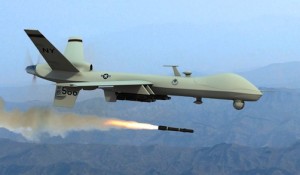Newspaper Article 02/04/2014
It was in 2001 that the United States (US) used unmanned aerial vehicles (UAV) commonly known as drones for the first time in Afghanistan and has been continuously employing them since then. The drones have been the US effective weapon of choice in Afghanistan, Pakistan, Yemen and Somalia in the past one decade or so. Unfortunately, despite causing much collateral damage, the opposition to drones had remained limited. Now, after all these years, the international community is slowly awakening from its deep slumber and raising voice over the drones. Controversy over use of drones is gaining strength.
Amnesty International produced a report on drones in October 2013. The report was based on a detailed field research conducted between 2012 and 2013. Amongst other things the report highlighted that the US may have committed extrajudicial killings and war crimes by killings civilians in Pakistan through drone strikes. The US does not take responsibility of these strikes that makes the matter even worse. One there is no mechanism to assess the harm caused to civilians. Two, the victims of these drone strikes cannot seek justice. The report categorically asked the US to conduct impartial and thorough investigations into the unlawful killings mentioned in the report and otherwise. The US was also asked to provide compensation to the families of the victims of these unlawful killings.
Although President Obama promised to make drone programme more transparent in May 2013, the follow up has rather been negligible as no new statement on drone policy or its legal framework has come out as yet. There is a need to ensure transparency of drone programme.
In December 2013, the United Nations General Assembly adopted a unanimous resolution against use of drones. The resolution called on all states to ensure compliance of counter terrorism efforts with the international law. It emphatically asked the states to seek agreement on legal aspects of use of drones. This resolution against drones was tabled by Pakistan.
Pakistan upholds that drones are counterproductive. They do not only add up to the cadre of militants but also foment anti-US feelings. There is much public fury against the drone strikes due to the havoc they have caused particularly the killing of hundreds of civilians. There are no authentic figures available but according to unverified account 951 civilians have been killed in drone strikes since 2004.
The European Union which has so far remained mummed about it has finally spoken up. The European position had not been so clear on drones, primarily because it was complicit and assisted the US in carrying out drone strikes particularly UK and Germany. In February 2014, an overwhelming majority of European Parliament passed a resolution asking the member states neither to perpetrate nor facilitate these unlawful killings.
The most recent country joining this international bandwagon against use of drones is China. In a report on Human Rights in the US released by the China’s State Council, China has condemned the drone strikes in Pakistan that have resulted in heavy civilian casualties.
A report by United Nations Human Rights Council released on March 10, 2014 stipulates that “in any case in which there have been, or appear to have been, civilian casualties that were not anticipated when the attack was planned, the state responsible is under an obligation to conduct a prompt, independent and impartial fact-finding inquiry and to provide a detailed public explanation of the results.” This proposal is most likely to be discussed by the UNHCR for adopting a resolution. The report notes that drone strikes in Pakistan have decreased during 2013 but increased manifold in Afghanistan and Yemen.
Slowly and gradually, international consensus against drones is building up. Much credit goes to human rights organization, think tanks, journalists and families of victims for revealing the truth and speaking up.
International community is perhaps concerned with the use of drones by other countries. Already Russia, Turkey, Saudi Arabia have expressed their willingness to develop or purchase UAVs. The fear is that a dangerous precedent has been set by the US. It is only a matter of time when other countries would use drones outside the battlefield since the US has taken it outside the recognized combat theatres such as in Pakistan. Following the US steps, they may not be compelled to disclose the targets. Their drone policy might be just as ambiguous and secret as that of the US.
Has the newly emerged consensus and damnation of drone strikes brought any meaningful results. After seeing a peak of 128 drone strikes in 2010, a total of 27 strikes were conducted in 2013 in Pakistan. In 2013, the drone strikes resulted in 4 civilian casualties in Pakistan according to Bureau of Investigative Journalism. Unfortunately, the drone strikes did not slowdown in other places such as in Afghanistan and Yemen where it has seen a manifold increase.
The drone strikes in Pakistan have come to a halt since December 25 in Pakistan. Though no formal statement has been made by the US on suspending the drone strikes but Pakistan Government believes that the US has finally understood Pakistan’s view. The halt has more likely to have come due to the growing international consensus against drones. It may not be long when the drones are completely abandoned as a weapon if the international consensus becomes irrefutable.
The article was carried by The Weekly Voice, Canada on March 29, 2014.
Disclaimer
The views expressed are solely those of the author and do not in any way represent the views of IPRI.



